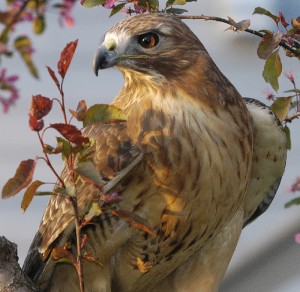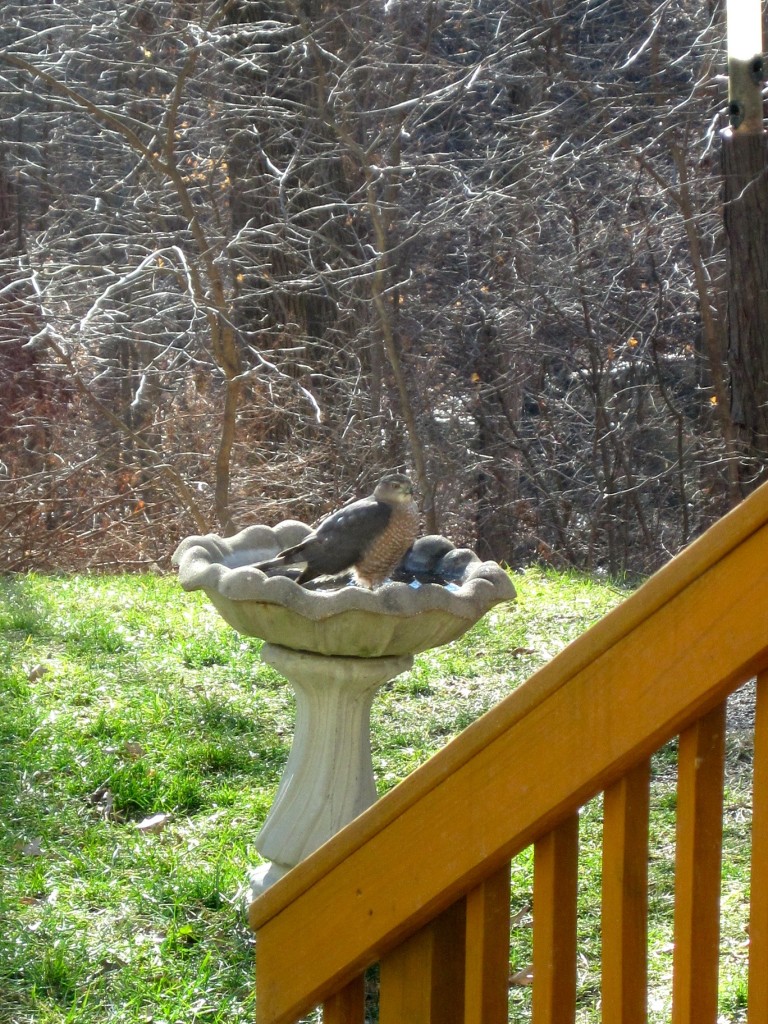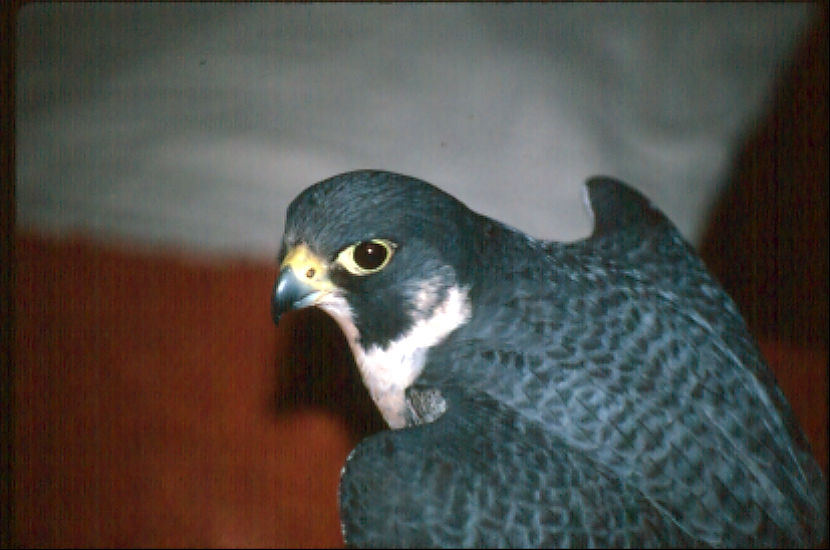Birds of Prey Are Powerful Predators in Our Ecosystem

The magnificent red-tailed hawk is one of the most easily viewed buteo species that live in our bluff lands as they often soar overhead and also will perch on utility poles. Photo courtesy Tom Rollins, ThomasRollinsPhotography.com
…The wild hawk stood with the down on his beak,
And stared with his foot on the prey.
Tennyson captured the simple occurrence, the happenstance of a successful predator’s hunt for food with these lines from The Poet’s Song. The sight of a hawk or falcon searching for and finding food is a thrilling experience. Hawks, falcons, eagles and owls are collectively grouped as raptors, or birds of prey that hunt, capture, kill, and consume other animals.
Raptor is derived from a Middle English borrowing from the Latin word for plunderer, “rapere,” meaning to seize or capture. All raptors are adept at seizing their food with powerful talons, long and sharply curved needlelike toenails. Raptors also have powerful beaks that are adapted to pulling and tearing their prey. Hunting behavior varies among the many species of raptors; some, like harriers, fly close to the ground as they search for small mammals; others, like peregrine falcons, soar high in air and then dive deeply and can seize a duck in flight; snail kites, an endangered species found only in Florida, capture apple snails by plucking them from water. Owls generally are active only at night, although barn owls with large numbers of nestling owlets may hunt during the day. Hawks, falcons, kites, and eagles are active in daylight hours only.
Our bluff lands, with large, unfragmented blocks of mature woodlands, interspersed with occasional glades, sinkhole ponds and creeks, and many field areas that have forested edges or are dotted with treed sinkholes, provide multiple territories for several species of hawks and falcons.
Hawks often are grouped into two types, based on appearance and hunting strategy. Accipiters or bird hawks, have short, rounded wings and long tails, a body form that allows them to move rapidly and agilely between tree branches and shrubs as they hunt in wooded areas.

This adult Cooper's hawk visited a local residential bird feeding station and took advantage of the bird bath. Photo courtesy Jennifer Lesko, Clifftop.
In our area, Cooper’s hawk is year-round resident accipiter species and sharp-shinned hawk is a winter visitor accipiter. Both species will sometimes dismay homeowners with bird-feeding stations as both species may view the gathering songbirds as an irresistible hawk banqueting station. But, rather than a sign of distress, the presence of hawks should be taken as proof that the bird feeding station is an extension and reflection of a natural habitat. The accipiters simply are making a fully appropriate use of a bird feeding station.
Buteos or soaring hawks, have broad wings and short, wide tails, and generally hunt in open areas, even though they may nest in woodlands. These are the hawks most often seen, as they soar overhead or perch in prominent spots including dead tree snags and telephone poles.
Several buteo species grace the skies over our bluff lands. Perhaps the most familiar and, indeed, the most common buteo of North America, is the red-tailed hawk. Our resident red-tailed hawk population will expand during the fall and winter as birds that bred as far north as Hudson Bay in Canada migrate to our area and further south. Although the trademark tail color helps with identification, red-tails can show amazing color variation, ranging from nearly black through brown to very pale, almost white birds that sport only pale orange shading on their tails.
Although a buteo, red-shouldered hawk is a woodland dwelling species. Like red-tails, these hawks are year-round residents of our bluff lands. Their clear, loud calls, especially common in spring nesting season, often are imitated by blue jays which find the mimicry a good means of temporarily clearing the competition from bird feeding stations. The chestnut-colored wing patch that gives red-shoulders their common name is most visible during the bird’s flight. Perched birds show bright chestnut stripping across the breast and belly. Their populations have declined over much of the eastern United States as large woodland areas have been fragmented.
Broad-wing hawk also is a woodland-dwelling buteo species. The smallest of the buteos, broad-wings are long-distance migrants, making their twice-yearly journeys from North American breeding grounds to their wintering areas in South America. Unlike many small songbirds, including hummingbirds, broad-wings do not cross the Gulf of Mexico, but fly overland along the Texas gulf coast and then through Mexico and Central America. Their aversion to the water crossing is the result of the hawks’ energy-saving flight strategy of relying on land-created thermal heat updrafts which allow them to soar and glide, instead of active and energy-sapping wing flapping.
Their soaring skills are on full display during the spring as broad-wing males and females court high in the sky. The birds circle high on thermals and sometimes engage in sky dancing: a series of closed-wing dives followed by sharp upturns and sometimes a full rollover in the air. Broad-wings nest in healthy woodlands and become secretive and hard to see during their nesting season.
One species of falcon is a year-round resident of our area. American kestrels live throughout nearly the entire continental United States and will breed as far north as southern Alaska. These fairly small birds live in open country, but will even utilize parks in cities and towns. In our area, kestrels often can be seen perched on utility wires as they scan for prey. Though kestrels most often perch and swoop to capture food, they also can hover over a field as they look for food. As is the case with most raptors, females are slightly larger than males. Unlike the other raptors of our area, kestrels exhibit distinct sexual dimorphism in plumage. Like many songbird species, male kestrels are colorful, sporting a combination of bright rufous and blue-gray feathering. Female American kestrels show rufous coloring on the back and wings but has a brown, rather than bright gray-blue, color on the wings. Both male and female American kestrels have black stripes on their faces.

The beautiful peregrine falcon occasionally soars over our bluff lands. Photo courtesy Scott Ballard, Illinois Department of Natural Resouces.
Peregrine falcons occasionally are seen in our area and may nest in our bluff lands. Much larger than American kestrels, both adult male and female peregrines are gray above and show dark head feathering which extends, helmet-like, in a wedge below the eye. Like accipiters, peregrines primarily feed on other birds and often seek ducks and other waterfowl. These falcons are amongst the most thrilling to watch hunt as they often conclude their aerial hunt in a steep vertical dive which has been clocked at speeds of up to 250 miles per hour. That we may thrill at the sight of a wintering Peregrine is only due to an intense reintroduction program.
The naturally occurring population of peregrines in the Eastern U.S. and Canada, a subspecies called the “Rock Peregrine,” became extinct in the early 1960s, a loss largely attributed to the pesticide DDT. This pesticide, extensively used to control insects on crop and forestlands from 1946 to the early 1970s, undergoes chemical transformation in animals and increases in both concentration in tissue and effects as it moves up the food chain. As plants, insects, spiders and other food items that were exposed to DDT were eaten by birds, which, in turn, became food for peregrines and other raptors, the amount and resulting toxicity increased. The metabolized pesticide did not kill adult birds; rather it made the females less able to produce calcium. Eggs produced by the birds had shells so thin that the weight of the incubating adult birds simply crushed and destroyed the eggs.
Captive breeding programs, begun in the 1970s, have resulted in the release of more than 6,000 Peregrines in Canada and the U.S. The Midwest recovery effort was begun in Minnesota in 1982. But, the peregrines of the Midwest and the Eastern U.S. are not the same as the peregrine population that had lived here. The captive-raised birds and their descendants are the result of breeding efforts with up to 12 different subspecies of birds, including some from Europe.
The difficult and transformative return of peregrines and the near extinction of American Bald Eagles from the continental United States – also due to the deleterious effects of DDT – led to the adoption of strong protective measures for all raptors. That we may continue to thrill at the sight of birds of prey in our bluff lands is a result of hard-won conservation efforts.
Clifftop is hosting a program on hawks and falcons from 1 to 3 pm on Saturday June 14th at the Monroe County Annex Building, 901 Illinois St., Waterloo. The program will be presented by Pam Lippert of TreeHouse Wildlife Rehabilitation Center, Dow, Illinois, and Pam will bring a number of birds for us to see and photograph. This program is part of the continuing seminar series “Meet the Neighbors” sponsored by the Monroe-Madison-St. Clair Unit of the University of Illinois Extension Service and Clifftop. The program is free and open to the public. Advance registration is required by June 12th and may be made by email to Clifftop@htc.net or by telephone at 618-458-4674.
CLIFFTOP, a local nonprofit organization, is focused on preserving and protecting area bluff lands.
A version of this article appeared in the 6 June 2013 edition of the Monroe County Independent.
© 2014 all content rights reserved Clifftop NFP
Comments are currently closed.
